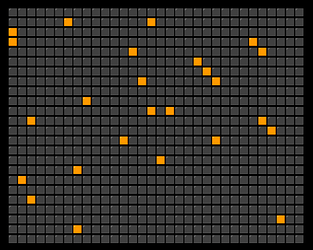What did you use to display the image?
A text display.
Did you convert it into 1s and 0s, and then that into emojis using the new text blocks?
Add activity feed for everyone: X + " " + Y.
Also, I think I might have found a way to find where the cursor is. So you know that when you have a weapon, you can see slightly farther in the way your cursor is than when you don’t have a weapon. I was thinking that you could use zone broadcast suppression so that when you look in a certain location, it causes the zones to broadcast and update the viewing angle. You would have to reset it every time people look around.
I tested it, and it seems that render distance is based on where the player is rather than the camera since the counter I was testing was only rendered when I moved in a certain distance. (Good concept though)
Yeah… I definitely will make a better version at some point haha.
Anyway, does anyone want to discuss trying to maybe make a better 3D renderer? So far we’ve done wireframe and point, but what about filling the sides of the cube in?
You would probably want to use the points on the line, and then just run the code again that gives you the points on the line, but just with the points you just got. You would have to figure out which sides the player can see, and then only display those. Also, I was thinking, do you want to work with me to create the best 3D renderer? We could combine the best parts of our systems to make the best system.
I’m really tempted to do some sort of parametric thing, where we store some conditions for areas of one color and such before applying a wireframe. So it would color in the cube based on some sort of inequality check and then it would apply the wireframe algorithm after. I just don’t know what sort of checks would make this viable.
I love the idea… but I don’t really work well with people and trying to organize when to work on the map is painful. I’m perfectly happy to work together with trying to find algorithms to use for things though.
I think the traditional approach, from my research at least, is to break the cube into triangles and try to fill those. Maybe the thing you’re suggesting might work better, can you try and make a prototype for it?
Mm, pretty useful (gets idea)
It’s better to use triangles since nearly any 3d shape (except “perfect spheres”) can be formulated using triangles – overall better in maximizing computing efficiency and simplicity in the rasterization process.
some info and sources I used can be found here:
- https://www.scratchapixel.com/lessons/3d-basic-rendering/rasterization-practical-implementation/overview-rasterization-algorithm.html#:~:text=In%20summary%3A,Rasterization%20is%20object-centric.
- Rasterisation - Wikipedia
- https://www.quora.com/Can-all-shapes-be-broken-down-into-triangles
- Explaining basic 3D theory - Game development | MDN < one of the best guidelines on 3d rendering (apart from scratch forums/DadOfMrLog or TheLogFather scratch projects I used in learning for implementing 3d stuff)
The shortest way I found of filling in all faces would require a block code to be run 400 times… per face.
You can read the editing history, but I don’t want to do this. I just found out how hard ray tracing is. I might be able to do it, but it will take forever.
What algorithm are you using?
I was going to do that. My equation went like this: xOnLine=xPoint1+t(xPoint2-xPoint1)
It’s the same for y. Just replace the x with y. t is a value between 0 and 1. I had it render 20 points on a line. So t=0/20, t=1/20, etc. It was able to render 360 points (x,y) in 1 second. Although, I might have discovered a faster method for filling in the cube. (Potential 4 seconds?)
Sweet! (Sorry i was offline)
